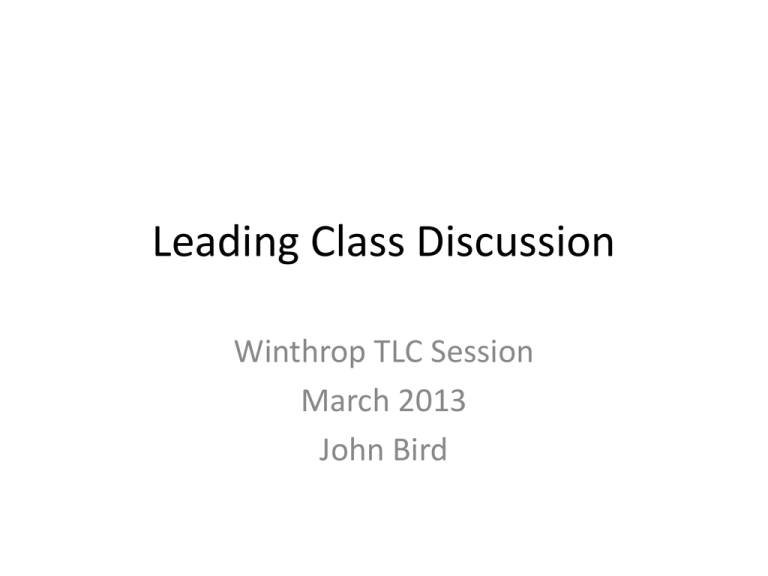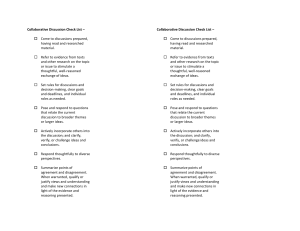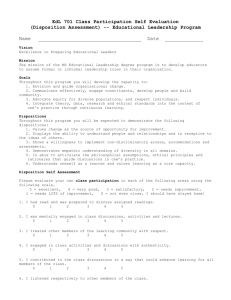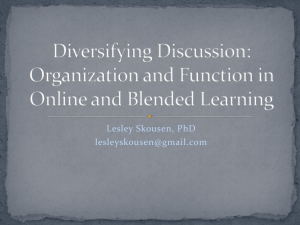Leading Class Discussion Winthrop TLC Session March 2013 John Bird
advertisement

Leading Class Discussion Winthrop TLC Session March 2013 John Bird Open vs. Closed Questions • Closed questions lead to specific answers: What? Who? When? • Open questions lead to speculative answers: Why? How? So what? • Closed questions are useful to pin down specifics • But open questions are the best for full discussion • Good to begin with closed questions and move to open questions—then repeat and vary Questions, Not Answers • Make sure your questions are actually questions, not answers • Not good: “The causes of the civil war were really important, weren’t they? • Better: “What is the significance of the causes of the civil war?” The Sound of Silence • One of the biggest mistakes instructors make is asking a question and then answering it immediately • Don’t panic—wait for the students to think • Rephrase the question if you think it was not clear • But WAIT! Be silent and they will answer (eventually) The Importance of Listening and Feedback • You must listen intently to student answers to guide a successful discussion • Don’t be thinking so much about the next question that you ignore what students are saying • Give good feedback, both through comments and body language • Listening is the key to the flow of the discussion Guiding Without Directing • Leading a discussion means being the guide rather than the director • When a discussion goes well, your role becomes akin to a traffic cop • Don’t over-prepare notes and questions: doing so will move you toward forcing the discussion rather than leading • Have a plan, but make it minimal—be ready to follow new paths • Live in the moment and go with the flow Event/Object/Meaning • For a good discussion, follow the pattern event/object/meaning • Before students can discuss and analyze, they must have experienced the object of discussion—in other words, they must have had an “event” • The event is usually reading or preparation before class • But students often skip the “event” Event/Object/Meaning (cont.) • If you get a sense that students are not prepared, recreate the event: read a passage, or have them read aloud (better) • If visual or aural, look or listen again • When you are sure the students have experienced the event, move on to the object • DON’T try to jump right to meaning: “What does this mean?” “Why is this important?” Event/Object/Meaning (cont.) • Instead, examine the object: the text, the chapter, the painting, the theory, etc. • Ask closed questions to make sure students understand the object: “What are the five stages that Piaget outlines?” • Move to open questions about the object: “How does stage one operate?” “How do these stages relate to your experience?” Event/Object/Meaning (cont.) • Continue asking closed and, more often, open, questions about the object • The discussion will move toward meaning naturally if you guide the student through fully discussing the object • Allow the students to arrive at meaning— multiple meanings, multiple conclusions— don’t just stop at one Problems • • • • Students who talk too much Students/classes who won’t talk Bad Questions/Bad answers Digressions Students Who Talk Too Much • Call on other students • Make a comment such as, “Now don’t let Jason do all the work.” • Announce that you want to hear from everyone who has a comment before you hear from anyone twice • If the problem persists, have a private talk with the student, thanking him or her for the contributions, but pointing out why it is important to have everyone participate Students Who Won’t Talk • Try eye contact with reluctant students • Call on specific students, if you feel comfortable with that • Comments such as, “Now let’s hear from someone who hasn’t talked yet.” • Try group work or writing first; students will be more comfortable sharing with the whole class if they have already done some thinking Classes Who Won’t Talk • Some classes will be stubbornly silent; remember to wait them out • Silent classes may be unprepared or not engaged: remember event/object/meaning—make sure that they have experienced an event • Group discussions can break down the class reluctance—you must provide clear questions • Writing BEFORE answering can break the silence Bad Questions • We all ask bad questions occasionally; regroup and rephrase • Remember to mix closed and open questions, generally starting with closed questions and moving to open—and then repeating the process • Think about your questions right after class—if the discussion was good, what kinds of questions did you ask? If not so good, what were your questions? Bad Answers • When a student gives an answer that is clearly wrong or the result of illogical or sloppy thinking, resist the urge to correct immediately • Turn the bad answer back to the class: “What do you think about what Mary said?” • Gently guide the students back to better answers: “Is that what the text says? Do you think you understood that correctly?” Students can often figure it out for themselves Bad Answers (cont.) • Sometimes an answer is so bad that you should just move on… Digressions • Don’t be alarmed at the first sign of an apparent digression—the discussion might go down a path even better than the one you planned • If the discussion begins to get way off track, gently lead it back: “That’s an interesting interpretation, but let’s go back to the text. What is the main point of the third paragraph on page 147?” Variations • • • • Group discussions Written discussions Mini-discussions PowerPoint discussions Group Discussions • As noted above, group discussions can be very valuable: they break the dynamic of the class, they put students in control, they involve more students, and they allow reluctant students to participate • Consider making permanent groups for your class if you will use group discussion often—students will become more comfortable with people they get to know • It helps to have a group leader, in both permanent and temporary groups Group Discussion (cont.) • Groups must have a clear task—an object to analyze, a problem • It helps to provide a list of questions—students will wander aimlessly without them • Move from group to group and help them stay on track, on task—pose new questions as you visit the group • Have a class discussion after the group discussion to share ideas and make sure the whole class is on the same page Written Discussions • As noted above, writing can be a good way to spark discussion • When you ask a question, rather than ask for an oral answer, ask the students to write the answer—then call on volunteers • You can conduct a whole class or a big part of it as a written discussion, what I call a “write around” Write Around • In small groups if the class is large, or in a circle if the class is smaller, pose a question and have the students write an answer • (I always sit in the large group, and sometimes in a small one, and write too) • After a few minutes, tell them to pass their paper to their left, read the answer, then respond in writing • Repeat for another cycle or so, then pose a new question • At the end, students get their papers back, full of discussion Mini-Discussions • If you lecture as your main way of teaching, build mini-discussions into your lecture • Stop after making a big point (your lecture becomes the “event”), then conduct a discussion • A lecture punctuated with three or four minidiscussions will hold student interest better and help them to better engage with the material and think rather than passively receiving PowerPoint Discussions • PowerPoint can be mere information and a set of closed questions • Try using a “Reverse PowerPoint”: make the bare bones of an outline, then have students fill in the bullet points (preferably, have one of them type in the content) • Work discussion questions, closed and open, into the PowerPoint—pause and have a discussion during the presentation Evaluating Discussion • I want to deal with this topic more fully in a follow-up session, but a few ideas • I don’t really evaluate discussion, as in grade it—I assume that discussion has its own value in student learning • Dave Rankin, former director of the TLC and the HMXP trainer, advocates giving the students note cards, on which they write down every day how they participated • Several people have some good rubrics for evaluating discussion, which I will collect and share Conclusions • Class discussion is one of the best ways for students to take control of the class material, to think about it deeply, and to become engaged in the class • Some people are better than others at leading discussion, but all of us can get better with good techniques and with practice • Remember the main points of open questions vs. closed questions, waiting for answers (silence), and event/object/ meaning • When a discussion goes well, it can be among your most rewarding teaching experiences—it’s worth the risk and the pitfalls! Materials • Stephen D. Brookfield and Stephen Preskill, Discussion as a Way of Teaching (Jossey-Bass, 1999) LB 2331 .B679 1999 [the best book on class discussion that we have in our library, as far as I can tell] • The Art of Discussion Leading (video from the Derek Bok Center at Harvard—I have not seen all this, but you can find parts of it on YouTube) LB 2393 .A77 1995 Materials • A worksheet from Carleton College, for students leading discussion, but has some good tips for instructors too: http://apps.carleton.edu/curricular/history/study /leaddiscussion/ • From the TLC at Hanover College, taken from English professors at Virginia Tech, Fostering Effective Class Discussions: • http://www.mhhe.com/socscience/english/tc/dis cussion.htm Materials • Good on group work, from Tools For Teaching by Barbara Gross Davis (we have this book in our library, and it is good): • http://teaching.berkeley.edu/bgd/collaborativ e.html • From Columbia University, good guidelines for leading discussion: • http://www.columbia.edu/cu/tat/pdfs/discuss ions.pdf Materials--YouTube






